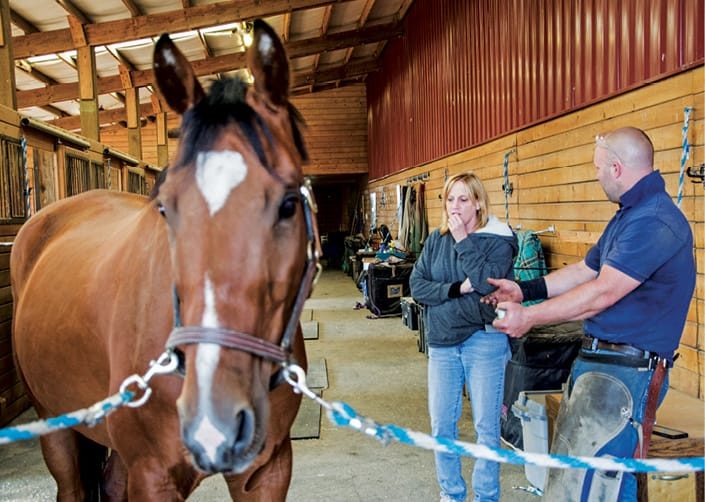As your shoeing career progresses, you are going to have clients who raise your blood pressure as soon as you see their name on your schedule. After working hard to build a solid business, getting rid of clients seems to fly in the face of your desire to increase your client base and income. But firing clients just might be what your business and your mental health need.
“Entrepreneurs have this horrifying sense of scarcity, that the customers they have are the only ones in the world,” says G. Richard Shell, professor of legal studies and management at the University of Pennsylvania’s Wharton School. “That is not true. But [firing clients] takes courage.”
Of course, you don’t want to fire a client who you cannot afford to lose. Just because you don’t like them or they are sometimes a problem doesn’t mean that these clients need to be fired. Normal problems are just part of being in business.
Farrier Takeaways
- Dismiss clients with cause to protect perception of your professionalism, as well as that of the industry.
- Some client characteristics call for immediate dismissal, while others might call for further management of the relationship.
- Despite the circumstances, never let emotions rule your behavior and leave with the best possible impression.
Discharging Clients For Cause
Before deciding to part with a profitable client, make sure you can replace or survive the financial hit of the income loss. That means making up for lost revenue by redoubling efforts to bring in new business.
Don’t wait until you are mad before discharging a client. When you just absorb the abuse until you can’t take it anymore and then fire the client in an emotional outburst, you will give the client the impression that you are unfit to work with animals because you are too immature or emotionally unstable. You will also give the client an excuse for their behavior (you’re unreasonable) and your reputation as a professional will be damaged. Be proactive in dealing with issues while you are calm and professional.
Do not fire a client using passive-aggressive behavior, such as refusing to return a phone call or not showing up for the appointment. Not returning phone calls or skipping an appointment will add to a non-professional reputation for you, as well as the farrier profession in general.
Clients should be discharged for cause. If fired with cause every time, a problematic client should eventually realize that the problem does not rest with the farrier or the farrier industry.
There are certain client behaviors that require immediate action:
- Farrier safety. The client values the emotional well-being of their horse more than the farrier’s safety. These clients excuse an ill-mannered or dangerous horse’s behavior because of some actual or perceived trauma that happened to the horse years ago. Because of this event, they expect the farrier to risk injury to demonstrate that they care about the horse. When a client would rather see the farrier injured than their horse controlled, it’s time to immediately fire them for cause.
- Physically abusive. These are clients throw and kick things when they perceive a disagreement or when they are complaining about you or your work. Or they might become aggressive, shout and challenge you in a threatening manner. Abusive people will probably calm down and apologize, but this type of behavior is ingrained in their personality and will happen again. You are much better off without them.
-
Verbally abusive. This client speaks poorly about you or others. For example, they often use descriptions that are directed at gender, race, nationality or other attributes. Comments that begin, “She/he is a good farrier for a ...” should trigger an immediate response.
Continuing to work for that individual only validates their verbally abusive behavior.
-
Potential for legal issues. As professional farriers, we have a legal duty to the horse. That means that anything you do to the horse must be in its best interest, not the owner’s, trainer’s or veterinarian’s. Following trimming or shoeing instructions that you know may be harmful to the horse is not a defense in legal action. Protect yourself by discharging these types of clients.
Then, there are behaviors that require an open and honest dialogue with the client that, if not solved, would result in firing them. Here are several examples:
-
They are never satisfied. Regardless of your efforts to provide exceptional service, these clients are never satisfied. There is always a complaint about your work, pricing or behavior — always something.
The problem with this client is that they share their complaints with every horse person they know or meet, which damages your reputation and erodes your confidence. You need to explain the damage their complaints are having on you and your business.
If attempting to have this conversation is met with resistance or if the complaints continue after your conversation, then they should be fired, politely and professionally.
Discharge dissatisfied clients by telling them that it is obvious that they have lost confidence in your ability to service their account. Emphasize the importance of confidence and trust between the horse owner and the farrier. Provide them with the contact information of other farriers, and say that it has been nice working for them and you hope that they find a farrier who can provide the service they require.
-
Unreasonable demands. This client likes to exploit the ambiguity in the farrier/horse-owner relationship. They know that the rules for this relationship are subjective and vary from farrier to farrier.
Decide what you will and won’t do in your client relationships and stick to these decisions. Explain to the client the boundaries of your service and ask what their expectations are of a farrier.
Once the client has articulated his or her requirements, the farrier can decide whether he or she is comfortable with providing that service. This would be the time that the farrier would explain fees for the services that the client is requesting that go beyond normal practice.
During this conversation, you might find that their expectations of a farrier exceed what you are prepared to do in your business. Explain this as you are dismissing them from your client list.
If, after this conversation, the client still makes unreasonable demands, describe that you have tried to live up to the expectation previously explained, but you feel that you and the client are not a good match.
Provide contact information for other farriers, thank the client and move on.
-
Looking for freebies. This client takes advantage of everything “extra” you do for their horse or them. One act of kindness becomes the demanded norm and then they need something else. Avoid this problem by having a fee schedule for every service you provide. Strictly adhere to that fee schedule for every client, no matter who they are.
If you have blurred the line with a client who demands more and more without intent to pay for the added services, you need to gain control of the situation.
Send or give each of your customers a letter explaining a fee increase. Even a small increase will open the door for a listing of services and the fee for each of those services. Give a date that this fee schedule begins and charge every customer for the services they receive.
If the client argues and complains about the fee structure, then it’s time to move on.
-
Slow to pay. Clients who don’t pay on time are more than just annoying. They consume valuable time chasing your money. Most farriers demand payment at the completion of the job. Those who habitually fail to pay immediately should be dropped from your clientele.
If you have a billing service and the client is slow in paying, either increase your fees for late payments or drop them from your list.
-
They don’t listen. This is the client who does not follow your advice and then expects you to pick up the pieces and fix things.
The best way to handle this type of client is to charge — and charge well — for anything that you have to do beyond your normal services because of their failure to follow your instructions.
An example would be a horse that a veterinarian has prescribed egg-bar shoes. You tell the client that this horse needs to have bell boots on if turned out and that the horse needs to be kept out of the pond at the end of the pasture. Explain that failure to follow these instructions will cause additional fees if you have to return to replace a lost shoe.
Then the client calls and complains that the horse has lost a shoe and wants you to come out immediately and replace it. If the horse was turned out without bell boots and/or went into the pond, there should be a charge for replacing the shoe, as well as any reconstruction that needs to be done to the foot.
Any complaint about the charges from a client is grounds for dismissal.
Following instructions that you know may be harmful to the horse is not a defense in legal action …
Firing clients is an unfortunate, yet inevitable task in our industry. Knowing when and how to do so requires professionalism, tact and the ability to communicate. These skills need to be developed by the farrier. Once you can master this skill, you will experience fewer problems in your practice.








